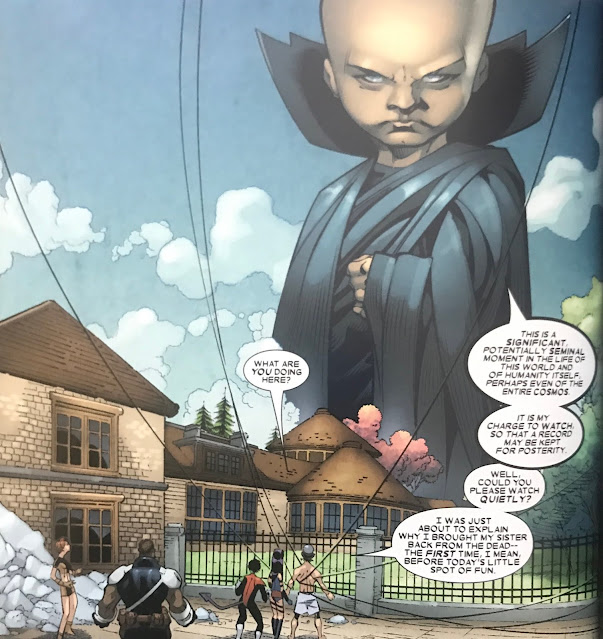X-Men Reload Volume 2, by Chris Claremont and Chris Bachalo
2000s, collected in 2019
In February, I read the first collection of Chris Claremont's final Uncanny X-Men run and... it was alright. I enjoyed it, but I didn't love it. But I decided that if I was going to read that, I may as well finish off the run.
 |
| Has Chris Bachalo managed to work with more X-writers than anyone else? |
If it sounds like it's heaving along, it is. At this time, there was Uncanny X-Men, X-Men, and Astonishing X-Men, and X-Men Academy, and theoretically they were all in sync, but in reality, someone had to be making decisions that other writers were made to deal with. And Claremont had about two years on this book total before it was taken over by Ed Brubaker, so I have a feeling that Claremont was dealing with what he was given, not making the sweeping changes on his own.
 |
| Davis gets to draw gender swapped X-Men; that's good for a chuckle |
With the House of M crossover, Claremont uses it as an opportunity to do more Excalibur comics. He started his run with the X-Men fighting Captain Britain villain The Fury at Braddock Manor, so maybe he was dying just to relaunch Excalibur. Alan Davis gets an opportunity to do wild variations of Marvel characters across realities, so that was alright. Ultimately, the arc was alternate reality filler. How much one enjoys these sorts of inconsequential stories, on a scale of Age of Apocalypse to Age of X-Man, depends on the creative team and the twist it brings. The four-parter, drawn half by Davis and half by Chris Bachalo, reads well enough, but I found it to be unmemorable. I like Captain Britain and Meggan as side characters, but they have trouble carrying an X-Men story.
 |
| The Blob is depowered in a subplot that fizzles out. He gets his powers back with a hand wave somewhere in a few years |
Then House of M ends, and a new status quo is thrust upon the series: 99% of the mutants have been depowered and the X-mansion is surrounded by sentinels for their protection. So much is made of the X-Men being at their weakest, and that the government is stepping up to protect them. In this time of vulnerability, who knows which villains will take their chance to deliver the final blow. The Reavers? Nimrod? Factor Three?
So the next six issues is a fight with Shiar black ops that have zero connection to this new status quo. They're there to destroy the Phoenix. It's like he was handed this complicated mess of continuity and just decided to do the Shiar thing he was already going to do anyway, and add a few panels about Sentinels at the mansion.
 |
| When Claremont starts narrating the history of a human character, they are 100% guaranteed to die within a panel or two |
 |
| I like the gray one |
Where I'm torn is that the Shiar Death Commandoes are bland characters with hard to grasp powers, not the first time Claremont has made such characters. It's not helped by Bachalo's art, which can be confusing as it is, but on gray armored characters, I couldn't tell what was going on multiple times. I was squinting on lots of pages.
I like Bachalo's art a lot in general, but it wasn't always in the service of storytelling here.
 |
| That's a great Bachalo illustration of Storm |
 |
| Maybe he shouldn't have played the Uatu card |
This last arc is about the inverse of the Phoenix force. Rather than a force of destruction and creation, this is a force of stasis. It's a strange story where reality-shifter Jamie Braddock isn't invincible, and the X-Men are zapped to an Egyptian-looking place where their powers are neutralized and aliens live in peace.
 |
| Roger Cruz does decent work; not my favorite, but pretty good |
 |
| That looks like art from a DC book |
If it sounds like I'm beating on the book, I guess I am. I read it quickly enough so I was enjoying it. But other than the story with compressed time in it, none of it really stuck in my memory. It was a fizzle. If Claremont had been writing this same stuff in 1989, it would have sunk in a lot more, but in comparison with what else was going on in the era, these aren't exceptional comics.
As this was finishing at the time, Ed Brubaker was delivering Deadly Genesis, a comic which was certainly memorable, though more infamous than beloved. His X-Men run starts the issue after this book ends with a 12 part space adventure which I enjoyed a lot. It felt fresh because he was dipping into the X-Men for the first time. In comparison, Claremont was doing what came naturally to him with his run, but after a lifetime reading his original 17-year run repeatedly, it's almost like a new Rolling Stones song. It's them, it's alright, but it just isn't hitting as hard as the old stuff did.

No comments:
Post a Comment